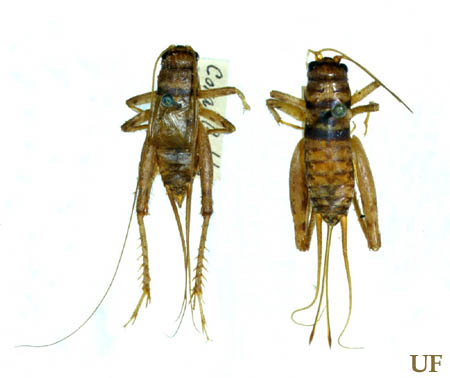
Female Choice
Despite competition between males for mates, it is females who retain primary control over reproduction. This is due to the fact that she alone produces eggs and exerts a great deal of control over which male's sperm will fertilize her eggs. A variety of factors come into play when a female decides which male she will allow to inseminate her--male resources, male appearance, and courtship displays all play roles. Males have evolved elaborate ways of influencing female behavior, and this evolutionary process has, over time, produced more and more effective operators in the arena of sexual interaction (Alcock 457).
Female Choice and the Role of Male Resources / Nuptial Gifts
It is theorized that males transfer resources to females effect how they 1) produce eggs, 2) choose partners, and 3) select sperm to fertilize eggs. It has been shown that males will sometimes provide nuptial gifts, usually in the form of a nutritious medium found in the ejaculate or spermatophore which the females can then incorporate into their eggs. Nuptial gifts are offered by males of numerous species, and occur in various forms. The effects of food gifts on female reproduction and offspring survival, and the ensuing benefits to males, vary greatly across species. Because of this variation, there has been considerable debate over the function of nuptial gifts.

In the decorated cricket, Gryllodes sigillatus, food gifts often take the form of a spermatophylax, a large gelatinous mass forming part of the spermatophore and consumed by the female after mating. The spermatophylax produced by G. sigillatus is 82% water by mass. Decorated crickets are extremely sensitive to desiccation, and rarely live more than a day without water. Nonetheless, the species often occurs in dry habitats where the availability of water is not always certain. Female G. sigillatus employs multiple mating as a ploy to obtain water contained in nuptial gifts, thereby enhancing their own survival. Photo courtesy University of Florida.
No discussion of nuptial gifts and male resources would be complete without mention of the dramatic case of certain mantids and spiders. In some species, such as the praying mantis, the female is much more aggressive and larger than male and often devours the male's head while mating or shortly thereafter. It is the female who initiates copulation by releasing pheromones. Females clearly gain nutrition from the cannibalistic act, but do males that are eaten gain sufficient fitness benefits to warrant "voluntary sexual suicide?" (Alcock 461) Based on the observations of the male redback spider, it appears males do benefit from consumption by a female. The male redback spider seems to make every attempt to persuade his mate to eat him--the male performs a somersault during the sexual act, bringing his body right next to the female's jaws. Most of the time the female will comply and consume her mate. The male does gain fitness benefits in death--he fertilizes more of the female's eggs posthumously than he would if he survived the copulatory act and the female is less likely to mate with other males once she has mated and consumed a male.

The female redback spider (left) and the praying mantis (right). Redback spider image courtesy the Museums of Queensland, Australia. Praying mantis image courtesy The Bugstore.
Female Choice and the Role of Male Appearance and Courtship Displays
In some species, the appearance of the male or his courtship displays influences a female's decision to mate with him as much or more than material considerations. Females generally prefer more intense and more varied courtship stimulation, favoring males with larger, more brightly colored ornamentation, more extreme rates of acoustical or tactile display, or combinations of all of the above (Kodric-Brown). It is theorized that females take these cues as indications of virility and what the male is able to offer in return for copulations. Female water frogs, for example, tend to be attracted to the males with the loudest and most distinctive mating call (an acoustical display). The information the female gains from hearing potential mates call allows her to select the male that will offer the most in return for copulations. Hear the mating call of the water frog, Rana lessona.
Symmetry also can play a role in female selection of mates. Females tend to prefer symmetrical males over asymmetrical ones. The female preference for symmetry has been observed in barn swallows (tail symmetry), zebra finches (leg coloration), Japanese scorpionflies (wing length), and in the facial and body structures of humans. What material benefits might be gained by a female who selects only symmetrical mates? Perhaps asymmetrical males are generally less effective parents or provide lesser nuptial gifts (Alcock 468). Also, male asymmetry arises frequently as a result of environmental insults that disrupt homeostasis and equal development of both halves of the body (Alcock 468). Thus body asymmetry is associated with poor health or bad genes by females, forming the basis for their preference for symmetrical mates.

Film actor Mel Gibson is a good example of facial symmetry and corresponding attractiveness. Note the symmetry about an imaginary line running down the center of his face (from hairline to chin). Gibson's symmetry (and resulting good looks) have made him a popular sex symbol among members of the opposite sex.
Three alternative theories purport to explain the evolution of extreme sexual ornamentation and courtship displays by males. They are:
from (Alcock 468)